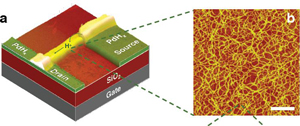Researchers from the University of Washington (located in Washington state) and Southeast University (China) have found a way to create organic ferroelectric molecules which offer the possibility of flexible, nontoxic memory chips according a Jan. 24, 2013 news item on ScienceDaily,
At the heart of computing are tiny crystals that transmit and store digital information’s ones and zeroes. Today these are hard and brittle materials. But cheap, flexible, nontoxic organic molecules may play a role in the future of hardware.
A team led by the University of Washington in Seattle and the Southeast University in China discovered a molecule [diisopropylammonium bromide?] that shows promise as an organic alternative to today’s silicon-based semiconductors. The findings, published this week in the journal Science, display properties that make it well suited to a wide range of applications in memory, sensing and low-cost energy storage.
“This molecule is quite remarkable, with some of the key properties that are comparable with the most popular inorganic crystals,” said co-corresponding author Jiangyu Li, a UW associate professor of mechanical engineering.
The Jan. 24, 2013 University of Washington news release by Hannah Hickey, which originated the news item, details the advantages of these crystals while noting they are not likely to replace currently used ferroelectric materials as the new molecule is not suitable for all uses (Note: Links have been removed),
The carbon-based material could offer even cheaper ways to store digital information; provide a flexible, nontoxic material for medical sensors that would be implanted in the body; and create a less costly, lighter material to harvest energy from natural vibrations.
The new molecule is a ferroelectric, meaning it is positively charged on one side and negatively charged on the other, where the direction can be flipped by applying an electrical field. Synthetic ferroelectrics are now used in some displays, sensors and memory chips.
In the study the authors pitted their molecule against barium titanate, a long-known ferroelectric material that is a standard for performance. Barium titanate is a ceramic crystal and contains titanium; it has largely been replaced in industrial applications by better-performing but lead-containing alternatives.
The new molecule holds its own against the standard-bearer. It has a natural polarization, a measure of how strongly the molecules align to store information, of 23, compared to 26 for barium titanate. To Li’s knowledge this is the best organic ferroelectric discovered to date.
A recent study in Nature announced an organic ferroelectric that works at room temperature. By contrast, this molecule retains its properties up to 153 degrees Celsius (307 degrees F), even higher than for barium titanate.
The new molecule also offers a full bag of electric tricks. Its dielectric constant – a measure of how well it can store energy – is more than 10 times higher than for other organic ferroelectrics. And it’s also a good piezoelectric, meaning it’s efficient at converting movement into electricity, which is useful in sensors.
The new molecule is made from bromine, a natural element isolated from sea salt, mixed with carbon, hydrogen and nitrogen (its full name is diisopropylammonium bromide). Researchers dissolved the elements in water and evaporated the liquid to grow the crystal. Because the molecule contains carbon, it is organic, and pivoting chemical bonds allow it to flex.
The molecule would not replace current inorganic materials, Li said, but it could be used in applications where cost, ease of manufacturing, weight, flexibility and toxicity are important.
Here’s a citation and link to the paper,
Diisopropylammonium Bromide Is a High-Temperature Molecular Ferroelectric Crystal by Da-Wei Fu, Hong-Ling Ci, Yuanming Liu, Qiong Ye, Wen Zhang, Yi Zhang, Xue-Yuan Chen, Gianluca Giovannetti, Massimo Capone, Jiangyu Li, Ren-Gen Xiong. Science 25 January 2013:
Vol. 339 no. 6118 pp. 425-428. DOI: 10.1126/science.1229675
This paper, along with a few others about ferroelectric materials in the Jan. 2013 issue of Science, is behind a paywall. Given the title of the paper, I’ve made the assumption that the new molecule is diisopropylammonium bromide.
At any rate, all of this has led me to an old song by singer, Dean Martin, titled ‘Memories are made of this,’
I found this piece of information in the comments,
neuro518 3 weeks ago
the guitarist is Terry Gilkyson and his group here is called the Easy Riders. He wrote this song and hundreds of others including “Fast Freight” performed by the Kingston Trio. He was in at the very beginning of the transition of American music from pop to folk and was one of the best. For some reason he never gets much credit, but he was one of the best.
Happy Friday, Jan. 25, 2013.
